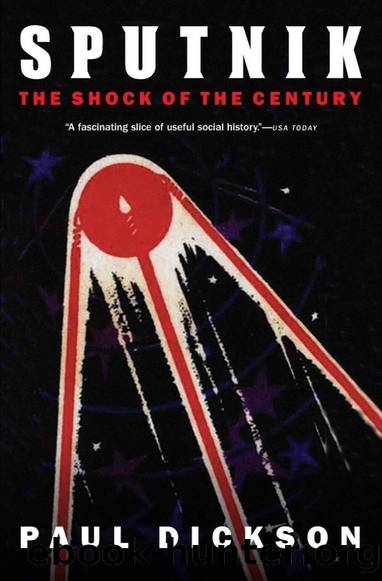Sputnik: The Shock of the Century by Paul Dickson

Author:Paul Dickson [Dickson, Paul]
Language: eng
Format: epub
ISBN: 9781496215727
Amazon: 1496215729
Barnesnoble: 1496215729
Publisher: University of Nebraska Press
Published: 2019-12-14T00:00:00+00:00
CHAPTER EIGHT
American Birds
The successful orbiting of Explorer 1 is one of the landmarks in the technical and scientific history of the human race. Its instrumentation revealed the existence of radiation belts around the Earth and opened a massive new field of scientific exploration in space. It inspired an entire generation of young men and women in the United States to higher achievement and propelled the Western World into the space age.
â1Astrophysicist James A. Van Allen, speaking on March 31, 1970,
when Explorer I reentered the Earthâs atmosphere
State University of Iowa astrophysicist James Van Allen, who was chairman of the Working Group on Internal Instrumentation of the Technical Panel Earth on Satellite Program, was in charge of IGYâs scientific payload that was to be sent into space by the United States. When Vanguard became Americaâs official choice for the IGY, Van Allen had joined Vanguardâs team.
Ernst Stuhlinger, of the Army Ballistic Missile Research Center in Huntsville, Alabama, was sent to Iowa to enlist Van Allen in the effort to get the Jupiter C selected as the IGY vehicle, even though work was progressing on the Vanguard. Van Allen studied the information and concluded that Stuhlinger was right. He sent telegrams to all the other members of the technical panel, urging them to drop out of the Vanguard program and join the Jupiter C-powered Orbiter mission. Van Allen, who was turned down by the panel, decided to design his package so that it would fit into either the Vanguard or Orbiter satelliteâjust in case.
In Huntsville, Alabama, the Rocket Team still faced the dilemma of locating a satellite and an experimental payload for its Orbiter mission. They had to work quickly and quietly because they were preparing for a launch without permission, let alone financial authorization.
Locating the satellite was easy. William H. Pickering, director of the California Institute of Technologyâs Jet Propulsion Laboratory in Pasadena, had been in a state of semi-readiness for some months, waiting for the green light to complete the upper stages of the Jupiter C rocket, including the final, fourth stage: the satellite that would actually go into orbit around the Earth.
Work on the Orbiter proposal continued on both coasts even though Washington officials had canceled it and given the order to stop all work. Those involved in the deception called it âbootlegging,â Albert R. Hibbs, a space science pioneer, later admitted: âAt JPL, we had for several months been building the satellite for Orbiter. We had a difficult time continuing, and bootlegged the whole job under the title of a re-entry vehicle program. When finished we locked up the satellite in a cabinet up in [the] solid-motor test area so it wouldnât be found.â
The satellite itself was no longer called Orbiter but rather Deal. When Orbiter was turned down, John Small, a section chief at JPL, made a pronouncement that is familiar to poker players: âThe winners laugh and joke and the losers yell âdeal.ââ The name stuck. While waiting to hear from Van Allen as to whether he
Download
This site does not store any files on its server. We only index and link to content provided by other sites. Please contact the content providers to delete copyright contents if any and email us, we'll remove relevant links or contents immediately.
| Automotive | Engineering |
| Transportation |
Whiskies Galore by Ian Buxton(41941)
Introduction to Aircraft Design (Cambridge Aerospace Series) by John P. Fielding(33095)
Small Unmanned Fixed-wing Aircraft Design by Andrew J. Keane Andras Sobester James P. Scanlan & András Sóbester & James P. Scanlan(32767)
Craft Beer for the Homebrewer by Michael Agnew(18200)
Turbulence by E. J. Noyes(7983)
The Complete Stick Figure Physics Tutorials by Allen Sarah(7339)
Kaplan MCAT General Chemistry Review by Kaplan(6904)
The Thirst by Nesbo Jo(6882)
Bad Blood by John Carreyrou(6586)
Modelling of Convective Heat and Mass Transfer in Rotating Flows by Igor V. Shevchuk(6408)
Learning SQL by Alan Beaulieu(6239)
Weapons of Math Destruction by Cathy O'Neil(6221)
Man-made Catastrophes and Risk Information Concealment by Dmitry Chernov & Didier Sornette(5958)
Digital Minimalism by Cal Newport;(5712)
Life 3.0: Being Human in the Age of Artificial Intelligence by Tegmark Max(5520)
iGen by Jean M. Twenge(5387)
Secrets of Antigravity Propulsion: Tesla, UFOs, and Classified Aerospace Technology by Ph.D. Paul A. Laviolette(5338)
Design of Trajectory Optimization Approach for Space Maneuver Vehicle Skip Entry Problems by Runqi Chai & Al Savvaris & Antonios Tsourdos & Senchun Chai(5040)
Pale Blue Dot by Carl Sagan(4961)
